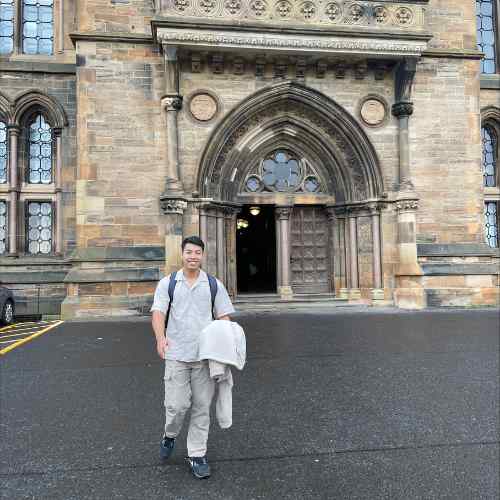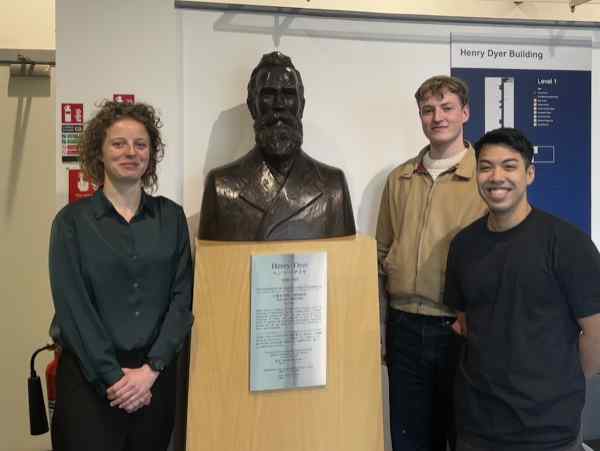BEng (Hons) Naval Architecture & Marine EngineeringNay Min Htein
Nay Min Htein from Myanmar came to Strathclyde to study on the BEng (Hons) Naval Architecture & Marine Engineering programme. He then decided to continue his studies at Strathclyde and pursue a PhD in the Department of Naval Architecture, Ocean & Marine Engineering. Nay Min shares his experience of studying at Strathclyde and his ambitions for the future.
How did you first hear about the University of Strathclyde?
I first became aware of the University of Strathclyde during my diploma studies in Singapore, where my lecturers and industry mentors spoke highly of the institution. They specifically recommended Strathclyde due to its outstanding global reputation and excellence in Naval Architecture and Marine Engineering, emphasising its strong industry connections and research excellence.

Why did you choose to study at Strathclyde?
The Department of Naval Architecture, Ocean & Marine Engineering (NAOME) has an impressive graduate employment rate, indicative of its strong reputation within the global maritime industry. Furthermore, Strathclyde’s extensive industry partnerships, renowned academic staff and alumnus assured me that I would gain a comprehensive and practical education directly applicable to professional maritime practice.
What did you enjoy about your undergraduate course?
What I particularly valued during my undergraduate course was the practical nature of the modules, incorporating projects based on realistic day to day naval architecture experiences. This experiential learning, combined with the application of industry-standard software, successfully connected theoretical concepts with professional practice, equipping me thoroughly for my future career.
How did you find the support from the staff in your department?
The staff in my department were consistently attentive, approachable, and sincerely dedicated to supporting students. On several occasions, professors took the initiative to highlight and provide information about scholarship opportunities and industry placements, greatly benefiting not only my own academic and professional growth but also that of my classmates.
What facilities have you had access to during your studies?
During my academic journey, I enjoyed extensive access to campus resources, particularly the Kelvin Hydrodynamics Laboratory, which features one of the largest towing tanks in the UK. This state-of-the-art facility enabled me to engage in significant experimental research, bridging the gap between my theoretical knowledge and essential hands-on experience.
What were your reasons for deciding to continue your studies at Strathclyde with a postgraduate research degree?
The decision to pursue further studies at Strathclyde was influenced significantly by the opportunity to extend my undergraduate fourth-year research project.
The continuity provided by the supportive professors and environment, combined with my curiosity for innovative research in naval architecture, made the decision a natural progression.
What have you enjoyed most about studying at Strathclyde?
One of the most enjoyable aspects of my studies at Strathclyde has been the strong connection between the Department of NAOME and the maritime industry. Regular opportunities to visit shipyards, engage directly with industry professionals, and participate in real-world projects have greatly enriched my educational experience and professional network.
What are your ambitions for the future and how do you think your time at Strathclyde will help you achieve your goals?
My goal is to significantly impact the field of Naval Architecture through innovative research and practical implementation. I believe that the comprehensive academic training, collaborative research initiatives, and extensive industry connections offered by Strathclyde will play a crucial role in helping me reach my objectives and build a reputation as a distinguished professional in the maritime industry.
Would you recommend Strathclyde to other people and why?
I highly recommend Strathclyde to prospective students. The remarkable academic guidance from professors, meaningful exchanges with PhD students and researchers, and direct access to leading experts in various specialised fields make Strathclyde an outstanding environment for academic and professional development in naval architecture and marine engineering.
I would also like to highlight the significant impact that the inclusive and dynamic community at Strathclyde has had on my educational experience. The collaborative atmosphere encourages innovation, personal growth, and professional networking, fostering a well-rounded academic experience for everyone.
Find out more
